JAPANESE YOUTH GROUPS
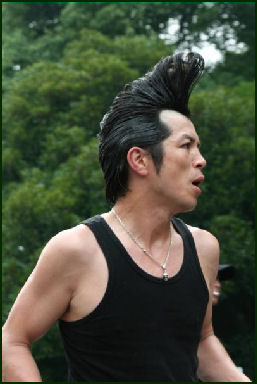
yanqui Members of the "Sun Tribe" sport surfer fashions such as Hawaiian shirts, bleached reddish blond hair, fake leis, sandals, and sun dresses with blood colored prints. At the beach you are just as likely to see sun tribe members carry cell phones as surfboards.
Japan has its share of punks. It is not unusual to see young people in Tokyo and Osaka with dyed blue and orange hair, metal studs in pierced noses and lips, tartan socks and leopard-skin pants.
There are also mods, who wear army parka, stovepipe slacks and drive around on Italian Lambretta scooters covered with mirrors, lights and metallic decorations. Mods have been around since the were inspired by the film “Quadrophenia”, which came out in 1979. Each year they gather for major rides through the city streets. An expensive A Lambretta TV200 with all the bells and whistles can cost $15,000 or more.
“Yanquis” (pronounced "yankees") sport dyed brown or blond hair, wear baggy track suits or flashy clothes such a “nikka-bokka” pants (derived from the word "Knickerbocker") and like to squat and smoke and talk of their cell phones. Yankees are linked to 1950s America and the greaser style, motorcycles, and James Dean rebellion. They first appeared in the 1980s and were one of the first groups that seemed to relish in being different and standing out. Many are construction workers.
“Chimpiras” are young quasi punks who have bleached yellow or orange hairs, and baggy suits. They look like the members of the British groups Duran Duran or Spandau Ballet and other new Romantics. They sometimes engage in petty crime and are notorious for harassing women. Their dream is to be recruited by the yakuza.
Freeters and Neets in Japan
Freeters (derived from the English word “free” and the German word for worker “Arbeiter”) is a term used to describe young part time workers. Comparable in many ways to Generation X slackers, they like to hang out and pursue interests like snowboarding and surfing, work only when they have to and reject traditional Japanese values such hard work and company loyalty.
In 2006, 48 percent of those between 15 and 24 and 26 percent of those between 25 and 34 were described as freeters. The number of freeters between the ages of 19 and 30 rose from 1.83 million in 1990 to 4.17 million in 2001, more than a fifth of the population between the age of 15-34, excluding students and homemakers. In that same time perieds freeters between 25 and 34 has tripled.
There are basically three types of freeters: 1) the dream-chasing type (13.7 percent), those who are pursuing dreams in things like pop music and manga drawing and don’t want to be burdened by a real job; 2) hiatus type (46.9 percent), those who have yet to decide what kind of career they want to pursue; and 3) no other choice type (39.4 percent), those who have tried but failed to get a regular job. One survey found that 72 percent of freeters would like to work for a company and have a regular job.
An official in the government Quality of life Bureau told the Los Angeles Times, “From the 1980s to the mid-1990s, most people close to be freeters for the purpose of living their lives according to their own interests. But now many have no choice because of the difficult job market. Aw the economy worsened people who became freeters in the “90s found they could not escape and cannot acquire job skills, Being a freeter was once a stage, nit possibly becoming a condition.”
NEET (not in education, employment or training) is another term used to describe young people not in regular jobs. A survey in 2009 counted 640,000 NEETS, 260,000 between 15 and 24 and 380,00 between 25 and 34. A survey in 2005 counted 640,000 NEETs.
In recession years, the number of so-called “freeters,” youths between the ages of 15 and 34 who are working part-time jobs (including dispatched/contracted workers) and/or are looking for a job, except for students and homemakers, increased from 1,830,000 in 1990 to 4,170,000 in 2001. One out of nine youths as well as one out of five youths (except for students and housewives) are freeters. More than 70 percent of freeters wanted to be regular workers but could not find jobs (Naikakufu 2003b). Recently, approximately 30 percent of high school graduates and about one-fourth of college graduates did not obtain regular employment immediately after graduation, and became freeters (Yamada 2001:124). Moreover, about 50 percent of all high school graduates, 40 percent of junior college graduates, and 30 percent of university graduates have left or changed jobs by their third year after graduation and finding employment (Ministry of Labour 2000:49). The MOE plans to send “freeters” to several-month long educational programs regarding information industry, welfare, and so on at 56 specialized training colleges in order to obtain regular jobs since the 2004-5 school year (AS August 18, 2003). [Source: Miki Y. Ishikida, Japanese Education in the 21st Century, usjp.org/jpeducation_en/jp ; iUniverse, June 2005 ~]
In 2003, among the youth between the ages of 15 and 34 years old (33,760,000), 22.01 million were in the labor force, including 2.17 million freeters, and 1.64 million unemployed. Outside of the labor force, there were 11.71 million youths, including students, homemakers, and 640,000 others who did not wish to work, called NEET (Not in Education, Employment or Training). The NEET includes delinquent youths, hikikomori (those who confine themselves in their homes and isolate themselves from the society), those pursuing their dreams, and those who lost confidence in working. They do not seek a job for many reasons: they cannot get along with people at work, they have not found the right job, they do not know their own abilities and aptitudes, they do not know how to look for a job, they are in poor health, or other reasons (AS October 2, 2004). The Ministry of Health, Labor and Welfare plans to provide a three-month training camp for these youths in order to generate an interest in working through job training. It plans to invite 2,000 or more youths at 40 places in 2005, and will eventually serve 10,000 youths per year (AS August 24, 2004). ~
Freeter Jobs
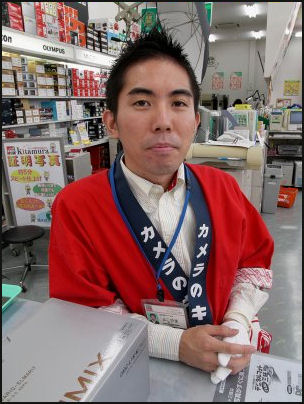
Freeters earn around $7 to $10 an hour working at 7-11 convenience stores, budget restaurants and clothing shops and are employed as sales people, lifeguards and warehouse workers. Some sell jewelry or other stuff on the streets or pass out tissues with advertisements on them at subway stations. Their career ambitions include becoming a professional DJ, playing in a band, designing video games and working as a manga artist.
The average freeter earns only $14,000 a year. That doesn’t go far on one of the world’s most expensive countries. Typically they change jobs 4.3 times in a three year period. More 50 percent do not contribute to the state pension system.
Many freeters want jobs that are flexible, give them free time, are not too demanding and allow them to wear the clothes and hairstyles they like. One study of freeters found that many lack career goals and "tend not to have any means of connecting their present situations to a future career."
In December 2012, Jiji Press reported: “More than half of homeless people under the age 35 were nonregular employees at their previous jobs, a survey by a welfare ministry panel of experts showed. According to the survey, which covered about 1,400 homeless people, 42 percent of all respondents said they were previously regular workers. [Source: Jiji Press, December 24, 2012]
In the age group under 35, the figure fell to 23.5 percent, but former nonregular employees, including temporary and part-time workers, accounted for 52.9 percent, the highest proportion in any age group, exceeding 46.4 percent in the 35-44 age bracket. Of all respondents, 45.9 percent previously worked in the construction and mining sector, the highest figure. Among respondents aged under 35, the service industry was top, at 41.2 percent, with the construction and mining sector at only 5.9 percent.
Freeter Lifestyle
Many young people worry that they will never get a payback for contributions they make to the social welfare system so they want to enjoy life now; get jobs that are easy to quit so they can travel, surf, snowboard, get high and have a good time. Social activism to change the system seems low on their priority list.
About 70 percent of freeters live at home. This means that much of their income is disposable and spent on fashions, hair care, traveling, clubbing, cell phones and having a good time. Many have died hair, tattoos and wear punk fashions. Those that live on their own spend money on rent and food and their hobbies. There are not particularly troubled because most of them have never had much money and are used to living without it. They generally don’t have children and are accused of worsening Japan’s population problems.
Some freeters lack ambition and desire to live a conventional lifestyle. A part time worker at a bakery in Tokyo told Reuter, “Living as a freeter, I got more freedom and I like that. Although I cut back on my spending, I have enough money to go out with my friends and I like that.”
Freeters are getting older and older. One 34-year-old man who cleans floors for a living and devotes his time to making music in his tiny Tokyo apartment told the Los Angeles Times, “When you reach my age, the chances of finding a proper job diminishes. Now I have come this far, I feel there is nothing for me but to carry on with this life I enjoy.”
Japanese Government and Freeters
The Japanese government worries that the increasing number of freeters while drag down the economy through loses in productivity, skilled labor and tax revenues and unwillingness to pay into pension and social service programs. They are particularly worried by the trend that freeters are getting older and older and the fact that few have marketable skills or have the desire or the money to raise a family and do anything to alleviate Japan’s population woes.
The government is funding organizations that support job seekers and help their receive training and find jobs. Schools get up job placement programs and began offering more vocational training courses.
To address the freeter problem, the Health, Labor and Welfare Ministry has set up places called Young Job Spot, or job cafes, where you people can get advise on job openings and training and talk to former freeters and get tips like that given by ex drug addicts to current drug addicts.
Japanese Schoolgirls
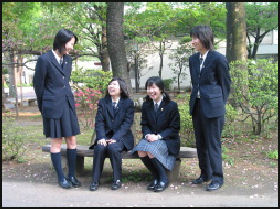
The biggest trendsetters — and fashion slaves — in Japan are teenage schoolgirls. They make up only four percent of the population but have a surprising amount of marketplace clout and a lot of cash to throw around. According to one study 68 percent of all Japanese teenagers receive a monthly allowance of $300 or more (compared to only 28 percent for American youth). They also receive regular "six pocket" cash gifts from their two parents and four grandparents. While boys tend to spend their money on video games, girls spend their on the latest fashions.
As one 17-year-old girl told the Los Angeles Times, "We want to be cute. We want to have fun. We like the same things." Most girls have cell phones and if they see something they like they can spread the word quick. Some companies have even hired girls to spread the word about new products by telling their friends to keep it a secret.
Fads travel very fast in the schoolgirl community. If a product is really hot it can spread in less than a week. If five percent of the girls like something 60 percent can be into it in a month.
Schoolgirls, Maids and Sex, See Sex
Neo Homo Sapiens and the Narita Divorce
On terminology used in the 1990s, Yoshiro Hatano, Ph.D. and Tsuguo Shimazaki wrote in the Encyclopedia of Sexuality: Together with increasing urbanization and modernization, Japan, especially in recent years, is witnessing the emergence of a new type of young person - what may be termed Neo Homo Sapiens - who often does not accept traditional institutional human relationships and prefers living exclusively at the keyboard of a computer, communicating via networks, and avoiding direct human relations with the others. These young people are often cruel, lacking in interpersonal relationship skills in the sense of human relationships with the others, and unskilled in heterosexual or homosexual relations in later adolescent life. This is evidenced in the increase in older bachelors and in the increasing frequency of Narita divorce - divorce upon returning to Narita New Tokyo International Airport from a honeymoon trip outside of Japan - indicating the lack of patience, human relationship maneuvering skills, and inability to maintain a married relationship. [Source: Yoshiro Hatano, Ph.D. and Tsuguo Shimazaki Encyclopedia of Sexuality, 1997 hu-berlin.de/sexology ++]
What usually happens [in a Narita divorce] is that newlyweds take a honeymoon in a place like Australia or Hawaii, and the husband is so intimidated by overseas travel that he scarcely wants to leave his hotel room. The wife, on the other hand, has already taken several foreign trips with girlfriends and is much more comfortable with the idea of being abroad. She wants to spend her days scuba diving and her nights bopping in the disco, and she finds her husband a dreadful bore. So she dumps him at the end of the honeymoon, and they say a final good-bye at Narita (Kristof 1996a). [Source: Yoshiro Hatano, Ph.D. and Tsuguo Shimazaki, Encyclopedia of Sexuality, 1997 hu-berlin.de/sexology ++]
Otaku
“Otaku” describes a subculture of young, male geeks who lose themselves in a hermetic world of manga comic books and video games. In the past it was a derogatory term used to describe men who were obsessed with computers and hung out at game arcades and in the manga section of bookstores and had some issues that developed out of their passions.
Cyberpunk writer William Gibson defined otaku as a being “pathological-techno-fetishist-with-social-deficit...the information age’s embodiment of a connoisseur.” They embrace what Peter Schjedahl of The New Yorker called a bizarre mix of “apocalyptic violence, saccharin cuteness (“kawaii”), resurgent nationalism, and variously perverse sex.”
Otaku when roughly translated means “hey sir.” Otaku tend to fall into three different groups based on their obsession: 1) games and computers; 2) anime and manga: and 3) pop idols. There is some overlapping between the groups.
Otaku are seen as “anemic, inward-looking, vaguely autistic.” They prefer “things to people” and virtual worlds to real worlds. Etienne Barral, a French journalist who studied them, wrote: "They know the difference between the real and virtual worlds, but they would rather be in the virtual world."
“Otaku Encyclopedia” by Patrick Galbraith, a Ph.D, candidate researching otaku at the University of Tokyo, comes across more as a work by a fan than a scholar.
Moe and Women
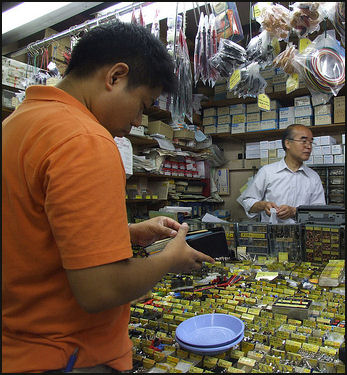
Otaku have their own expressions and slang. “Moe” (pronounced “moeh” and literally meaning “budding”) describes an overpowering love or fetish towards manga- or anime-related cuteness. Otaku expert Kanta Ishido described “moe” as “the sensation of being blissfully overwhelmed by cuteness or attractiveness.”
“Moe” is used in expressions such as “”Suzumiya Haruhi moe”,” a strong special feeling for the high school heroine of “Suzumiya Haruhi no Yuutsu”, a popular anime based on a novel for teenagers; “”Seira-fuku mie”, meaning a passion for sailor-style schoolgirl uniforms; and “”meganekko moe”, describing a fascination for girls wearing eyeglasses. “Moe” is seen as a word used by an otaku to express his emotions for objects of his desires. If they see something that gets their emotions going they exclaim “Moehhh!” as a kind of release.
On the role of women in otaku culture, Tom Baker wrote in the Daily Yomiuri, “masculinity has almost no place in the otaku world...whereas femininity runs wild — but not in any realistic or healthy form...The women...tend to be big-breasted fantasy figures striking suggestive poses while dressed in swimsuits, frilly skirts or cute cat ears. Few of the women look strong, intelligent or independent. As for the men, they are often nondescript, incidental figures gathered around a female “idol.”
Otaku Activities
Akira Fujitake, a communications professor at Gakushuin University told the Japan Times, "Despite their inner loneliness, Japanese youth don't want to be bothered by others. They like such devises as mobile phones, PCs, TVs and comic because they are free to access or shun them whenever they like."
Otaku specialist Makoto Fukuda wrote in the Daily Yomiuri, “There is a tradition in Japan’s otaku culture that even such things as trains or computer operating systems can be changed into cute characters in a way that turns inanimate subjects into characters meant to inspire a 'moe' response.”
Akihabara, a district in Tokyo, is ground zero for otaku culture. It is chock-a-block with sidewalk cosplay displays, small but influential, back-alley anime and manga stores and maid cafes. Within a several block area there are over 80 maid cafes. Akihabara got its start as a center of black market activities after World War II. In the 1950s and 60s it was known as the place to buy radios and appliances. In the 1990s it became known for personal computers Over the years a number of shops that specialized in video and computer games and anime-related products opened up and these attracted otaku.
On Sundays and holidays some of the streets in Akihabara are closed to traffic. In recent years these areas have attracted “cosplay” performers — people who dress up like manga and anime characters and put on street performances Some regard the performances as a nuisance because they disrupt the flow of shoppers and there has been some effort to control them. One woman was arrested for putting in a show that climaxed with exposing her underwear.
Some otaku are geeky juvenile delinquents. They are notorious for engaging in shoplifting, petty crime and small time arson and occasionally violent crimes with knives. When the term “otaku” was first used it had very negative implications. Tsutomu Miyazaki — a psychopathic killer who killed four children and cannibalized two of them and left an ear in box at the house of one of his victims — was described as an otaku after police found a lot of manga and anime in his apartment
Otaku and Maid Cafes
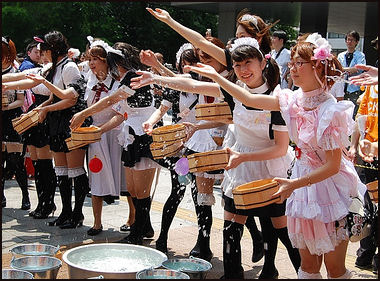
Role-playing cafes for men are popular in Tokyo. Most have waitresses dressed as French maids and target “otaku” — geeky fans of manga and anime. The trend reportedly began in the 1990s with a “love simulation” game in which players tried to win a date a with a waitress dressed in a maid costume.”
Some anthropologists say that one reason role-playing and dressing up are so popular in Japan is because they allow people to briefly escape the extreme social control and rigid norms of everyday life.
The cafes where young girls dress up like English or French maids are relatively harmless Most of the time the girls are simply waitresses. They don’t even pour drinks or flatter customers like hostesses do. Many of the clients are otaku. Many of the girls are cosplay fans.
In Akihabara there are over 80 maid cafes packed into a few block area and girls in maid costumes are frequently seem on the streets handing out fliers. The first maid cafes opened in Akihabara in 2000 and the popularity gained momentum after they were mentioned in the popular film “Densha Otaku”. Today there are so many and the competition is so stiff that its said you have to be special to survive.
In Akibara district there are maid cafes, maid bars, maid game center, and foot massage centers and oxygen salons with girls in maid costumes. The firm Candy Fruit rents out pairs of girls in maid outfits to do “entertainment housekeeping.” It charges ¥30,000 to send two girls and a chaperon to a customers house for two hours of chatting and cleaning.
Maids at cafes often greet otaku regulars with the greeting “oakari” (“Welcome Home”). The founder of maid training academy told otaku scholar Patrick Galbraith, “In a world where communication is getting ever weaker the relations between and intimacy established between maid and customer are crucial.”
Roles are reversed at the Newtype café in Akihabara where young men and pretty boys dress up in maid costumes and serve young women or male customers dressed in drag themselves. To work there thy boyd have to be cute. .
Otaku Chic
In the mid-2000s it suddenly became very hip to be an otaku. The geniuses behind Japan’s best manga, anime and Internet businesses all seemed to be otaku. One of the most popular books and films (“Train Man”) revolved around an otaku romance.
One party girl who said she had a thing for otaku told the International Herald Tribune: “They just come across as so much more sincere and relaxed about things. At this point, guys who dress well and take care of their appearances are slightly ridiculous, I can’t take them seriously.”
“Otaku” like synthetic materials over natural ones because they’re easier to wash; favor fleece pullovers in colors like spinach green from the discount store Uniqlo because they are the last on the shelves and go on sale at the cheapest prices; and still wear the gym clothes from high school. Money saved is used to buy the latest video game software or piles of manga and anime DVDs.
Otaku are famous for hanging on to their high school gym clothes — known in Japanese as “jyaajii” — and wearing them around their rooms when they play video games or surf online, In the mid 2000s, the fashion designer Comme des Garcons began selling old-school jyaajiis for more than $350. Burberry sells jyaajii in Japan.
One fan of the outfit told the International Herald Tribune: “The jyaajii is a strange outfit. It’s neither streetwear nor sportswear. No one can look good in it not even Brad Pitt or David Beckham. Still, we can’t not wear it. Personally I can’t think of relaxing on anything else than the jyaajii....My girlfriend says I look cute and geeky. She says it make her feel secure that I won’t go off and have affairs on the sly.
Train Man
Train Man — a book made from a collection of Internet chat lines messages that became a popular manga and then a popular television series and finally a popular movie — was a big deal in the mid 2000s. The story revolves around a computer otaku (nerd) who helped a beautiful girl who is harassed on a train by a drunk. He helped her file complaint at a police station and then received a gift — two Hermes teacups — with a return addresses. He then frets over whether to ask her out or not and seeks advice from a popular Internet chat line called 2-Chanel.
The book Train Man (“Densha Otoko”) is comprised of hundreds of messages from strangers to a real person, giving him advise on how to woo the girl. Train Man is the nickname the person used online and “Hermes” was the nick name of the girl. The book published by Shinchosha Publishers under the pseudonym Hitoru Nakan sold more than 1 million and spawned a whole new category of Japanese publishing.
The author of “ Train Man “ has never let his real identity be revealed. Otaku say he was not a true otaku because true otaku could care less about woman their true passion is computers and video games.
Among the other books created from one chat line conversations were “This Week My Wife Is Having an Affair” and “Reality Report: Diary of a Brutal Wife”. As for the real Train Man, he doesn’t do interviews and has refused to have his real picture published. Two months after the drunk on the train incident he and the beautiful girl confessed their love for each other and from what can be ascertained from the book lived happily ever after.
Bozozuka Motorcycle Gangs in Japan
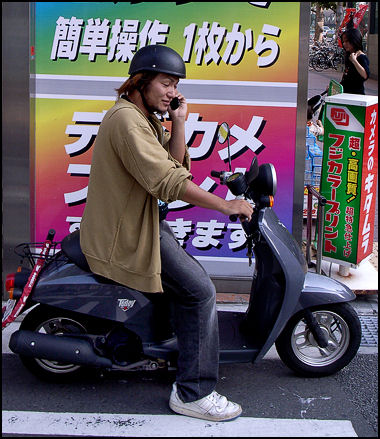
“Bosozoku” (literally "speed tribes)" are members of teen motorcycle gangs who have died hair, wear orange and red boiler suits with obscure Chinese characters painted on them. They like to race through the streets making as much noise as the can at 3:00am. Their idea of a good time is challenging the police and then making an escape (they rarely get caught).
Even though they have names like the "Death Squadron" and "Black Emperor, they are much tamer than their Western counterparts. Most of the members are in their late teens and early twenties. Bosozuku are fiercely loyal to the local chapters, which have initiation rites, membership fees, hierarchal structures and rules. They sometimes engage in petty crime.
Typical bosozuku hang out at the local Mister Donut. Boys wear ripped blue jeans and faded bomber jackets, while the girls sport aviator sunglasses and tattered T-shirts. At night they carouse video game parlors and attend Body Consciousness nights at the local night club.
According to the National Police Agency, the number of bike gang members in Japan slipped below 10,000 in 2010 to 9,064. Motorcycle gang membership peaked in 1982 when 42,510 members were counted. Membership has dropped, police say, because members are unwilling to recognize bike gang rules and hierarchies. Another survey found the number of bosozuka deceased from 15,086 in 956 groups to 13,677 in 847 groups between 2005 and 2006. They survey also found that members of the groups are getting older with adults making up more than half the membership.
Motorcycle Gangs and Crime in Japan
According to the National Police Agency in 2002, there were 24,669 bosozoku Bozozoku member were charged with 78,752 traffic violations, a 7.5 drop from the year before, and 5,376 criminal violations
Describing one group in Sendai, Akira Minami wrote in the Asahi Shimbun, “Revving their engines to red-line howls and moving at a snowman’s pace, the motley crew of “rodents” made its way down main thoroughfares — making a point of passing a police station — running red lights and hindering the flow of traffic.”
In 1999, members of hot-rod gangs clashed with police during the Ebisuko Festival held in November in Hiroshima. Police, with shields, confronted a group of about 50 youths after they prevented pedestrians from moving on a sidewalk. The youths began throwing bottles. Fights between police and youths broke out. Eighty youths were arrested. Later, laws were passed in Hiroshima that banned meetings of hot rodders and motorcycle riders.
In Sendai, many Bosozuku are connected with local yakuza groups. In some cases they pay the yakuza groups protection money so they can ride around unmolested by other gangs.
Bosozoku gangs are said to be in decline yet their noisy joy rides can still be heard in many places in Japan and many cities have well-known bosozoku hang outs and strips. In some places local resident have gotten fed up. In Okinawa 6000 people formed a rally and walked the streets chanting in Japanese “Uncool gangs get lost.”
In Adachi Ward in Tokyo authorities tried to break up groups of loitering teenagers using a “mosquito” devises that emitted high frequency sound. He ploy didn’t work. One of the places where the devices were set up was at a toilet in a woman’s room had been vandalized.
Image Sources: Ray Kinnane, Tokyo Pictures, Hector Garcia, xorsystblog
Text Sources: New York Times, Washington Post, Los Angeles Times, Daily Yomiuri, Times of London, Japan National Tourist Organization (JNTO), National Geographic, The New Yorker, Time, Newsweek, Reuters, AP, Lonely Planet Guides, Compton’s Encyclopedia and various books and other publications.
Last updated January 2014
